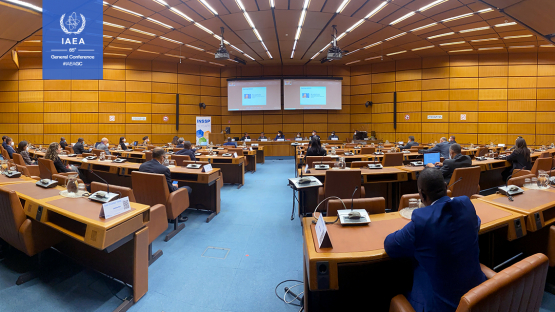
The IAEA today marked 15 years of the IAEA Integrated Nuclear Security Support Plan (INSSP), which lays the groundwork for nuclear security support by the organization. At a side event on the margins of the 65th IAEA General Conference, speakers highlighted the impact of INSSPs and how this support mechanism has evolved to better adapt to countries’ needs.
“INSSPs are flexible and relevant for all States, from those States establishing their national nuclear security regime to those that want to strengthen their regime and identify areas for improvement,” said Lydie Evrard, IAEA Deputy Director General and Head of the Department of Nuclear Safety and Security. The INSSP is a mechanism for States and the IAEA to jointly review nuclear security regimes and to help States to identify areas that need to be strengthened. It also assists with coordinating the provision of nuclear security assistance from the IAEA and other assistance providers.
Since 2006, 112 countries have taken advantage of the INSSP mechanism. Upon request, the IAEA supports a State in the development of its country specific plan that outlines priorities and develops implementation strategies and a timeline to complete activities toward enhancing the country’s nuclear security regime. The plan also identifies roles and responsibilities and helps to facilitate internal coordination among national authorities for different aspects of the nuclear security regime.
Based on guidance in the IAEA Nuclear Security Series, the INSSP is structured around six nuclear security areas:
- legislative and regulatory framework,
- threat and risk assessment,
- physical protection regime,
- detection of criminal and unauthorized acts involving material out of regulatory control,
- response to criminal and unauthorized acts including material out of regulatory control, and
- sustaining a State’s nuclear security regime.
In the past 15 years, 92 countries have endorsed their country specific plan, including Paraguay, which was the first country to approve an INSSP in 2006. The INSSPs of the other 20 countries are in various stages of progress.
“Paraguay saw the importance of considering nuclear and radioactive security as part of our national security strategy,” said Juan Francisco Facetti, Resident Representative of Paraguay to the IAEA. “We requested an INSSP mission from the Agency, and based on it, we prepared our first national nuclear and radioactive security plan.” The plan established institutional capacities for the measurement and control of nuclear and radioactive material to address the potential risks of the illicit traffic of nuclear and radioactive material.
As part of the INSSP mechanism, the IAEA and countries jointly conduct INSSP reviews approximately every three years to assess progress and reassess national priorities. About 105 INSSP Review Missions have been conducted, to date. “The INSSP is developed and reviewed taking inputs from all national stakeholders with nuclear security responsibilities, to ensure that the Plan depicts an accurate picture of the situation in a concerned State and is being owned by the State,” Evrard said. “Its benefits in connection to building and strengthening nuclear security coordination is well appreciated, and several States have established national nuclear security coordination mechanisms on the basis of their INSSP.”
Providing assistance, adapting to needs
Up to 80 per cent of requests for nuclear security assistance received by the IAEA are via the INSSP. From securing radioactive material in Colombia to the facilitation of a technical visit to strengthen nuclear security practices in Lebanon and Oman, the INSSP provides a customized framework to coordinate and implement nuclear security activities conducted by the individual country, the IAEA and potential donor countries. The IAEA’s nuclear security programme, including assistance provided to countries upon request, is supported by voluntary contributions to the Nuclear Security Fund (NSF).
“Canada values the INSSP process, in both identifying and prioritizing needs in a Member State. Through the Nuclear Security Fund, Canada and other donors are able to target resources to meet these needs, to maximize efforts and to collectively strengthen nuclear security globally,” said Nathalie Semblat, Deputy Director and Senior Program Manager of the Weapons Threat Reduction Program Division at Global Affairs Canada. Almost 50 donors, including Canada, have contributed to the NSF since it was established in 2002.
The INSSP has progressed to better address the needs of countries. Several updates to the INSSP template focusing on a graded and systematic approach have been introduced, the last of which was in 2017. The updates have improved its value as a mechanism for establishing sustainable nuclear security regimes and also as a decision making and advocacy tool for policy makers. Furthermore, the IAEA is restructuring the Nuclear Security Information Management System’s (NUSIMS) self-assessment questionnaires to simplify and realign them with the latest INSSP template. The questionnaires support and inform the INSSP process and contribute to planning and prioritizing activities to strengthen nuclear security.
“When we engaged with this INSSP tool 15 years ago, we didn’t know where the journey would take us. The INSSP gave us direction and steps to be undertaken,” Facetti said. “It has enabled Paraguay to develop a sustainable nuclear security regime that matches the country’s priorities and goals of its National Defence Policy.”
(iaea.org)